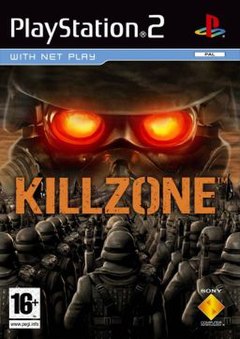Killzone (video game)
| Killzone | |
|---|---|
 European cover art | |
| Developer(s) | Guerrilla Games |
| Publisher(s) | Sony Computer Entertainment Europe |
| Composer(s) | Joris de Man |
| Series | Killzone |
| Engine | In-house engine |
| Platform(s) | PlayStation 2, PlayStation 3 |
| Release | PlayStation 2 |
| Genre(s) | First-person shooter |
| Mode(s) | Single-player, multiplayer |
Killzone is a first-person shooter, developed by Netherlands-based Guerrilla Games and released on November 2, 2004 in North America. The game was HD remastered and rereleased within the Killzone Trilogy and as a standalone PSN title on October 23, 2012.[1]
Plot
The game is set in an era of space colonization. Earth, after a serious nuclear war between its nations, formed a major government of the richest surviving governments and industries to explore space colonization, eventually settling in a solar system outside of Sol. Alpha Centauri is a system with two planets, the lush and blossoming Vekta, and the rich in energy supply but inhospitable; Helghan. These two planets were purchased by the Helghan Corporation after the UCN (United Colonial Nations) decided to auction them. However, after Helghast's economic policies threatened to undermine the UCN's financial system the UCN invaded Vekta and removed the Helghast after failing to impose financial sanctions. This forced the Helghast to colonize Helghan, a harsh and brutal planet, and deeply resenting the loss of Vekta. The planet's harsh environment forced the Helghast to adapt and mutate so much that they can no longer be considered human. They are stronger, faster and more resilient than their human cousins, and possess a burning hatred for humanity. Except for a small number of half-breed Helghast and trained troopers, they require a gas mask and air processing tank.
Story
The Helghast are a faction of human descendants who colonized the planet Helghan many generations ago. The Helghast Empire has recovered from its defeat in the First Extrasolar War and launched a blitzkrieg against the outer Interplanetary Strategic Alliance (ISA) colony planet Vekta.
The player takes control of ISA Captain Jan Templar, who is trying to repel the invasion. Despite the ISA's attempts, they continue to sustain heavy losses and the Helghast slowly prevail. Templar and his squad are called back to the base for reassignment. However, the ISA's headquarters is overrun by a Helghast assault force and they are forced to evacuate. Templar manages to hold off the invasion with the help of Marshal Lugar who rescued him from possible assassination in the abandoned HQ.
Templar and Lugar are then sent to find the ISA operative Gregor Hakha, a half-Helghast spy who had acquired data on future Helghast movements. On their way they meet Ricardo Velasquez; another ISA soldier who had just lost his platoon to Helghast forces and had rescued them from a large platoon of Helghast soldiers.
As they meet up with Hakha, the unit discovered that General Stuart Adams, a high ranking ISA officer, was a traitor. When the Earth Defense Fleet (EDF) arrived to assist the Vektan Army, Adams murdered General Vaughton and prepared an ambush for the EDF relief force. A string of skirmishes unfold across Vekta as Templar and his unit inflict strategic strikes across Vekta in a bid to unsettle the Helghast. General Adams' position of power falls into peril when General Lente assumes power, however he is shortly shot dead by the ISA-turned ex-Helghast soldier Hakha while the ISA calls off the ECA attacks on the station. Templar and his unit breach the station, and subdue resistance from Adams' loyalists. As the station explodes in orbit, the ISA heroes escape with Lugar and Templar trying to foresee the future of the conflict.
Reception
| Publication | Score | |
|---|---|---|
7 out of 10 (flashback score) | ||
| Review compilations | ||
This section may need to be rewritten to comply with Wikipedia's quality standards. (August 2013) |
Killzone received mixed to positive reviews. PSM stated that Killzone is "Graphically stunning and hits the mark in so many ways, it's baffling; they promised us we'd experience future war, and we have... and come away shaking."[2] Other reviewers cited technical problems with Killzone, including inconsistent AI,[6] occasional bugs, frame-rate issues, distracting graphical glitches,[6] repetition of the same voices,[4] short draw distance, and an awkward control system. Critics also complained about the gameplay, with IGN labeling it "underwhelming and mediocre"[6] and Into Liquid Sky stating that it "needs more refinement".[9]
Reviewers such as GameSpy[10] claimed that Killzone partly suffered due to the incredible publicity it received before release, raising expectations only for them to go unfulfilled. Despite this, Killzone was admired for its sound effects, its soundtrack, and its presentation of a gritty war zone;[6] it was also credited for its unique hard sci-fi art design.[10]
References
- ^ "Killzone Trilogy joins PlayStation Collection on October 23rd – PlayStation.Blog". Blog.us.playstation.com. Retrieved 2013-08-16.
- ^ a b "Killzone Critic Reviews for PlayStation 2". MetaCritic. Retrieved June 30, 2012.
- ^ GameRevolution.com's review of Killzone. URL retrieved 8 November 2006.
- ^ a b Gamespot review of Killzone. URL retrieved 8 November 2006.
- ^ GamingTarget review of Killzone. URL retrieved 8 November 2006.
- ^ a b c d e IGN review of Killzone. URL retrieved 8th November 2006.
- ^ Gamerankings.com page for Killzone. URL retrieved 2 October 2007.
- ^ Metacritic page for Killzone. URL retrieved 2 October 2007.
- ^ IntoLiquidSky review of Killzone. URL retrieved 8 November 2006.
- ^ a b GameSpy review of Killzone. URL retrieved 8 November 2006.
External links
- Official website (Killzone Command Center)
- Official website Template:Jp icon
- Killzone at PlayStation.com (North America)
- Killzone at MobyGames
